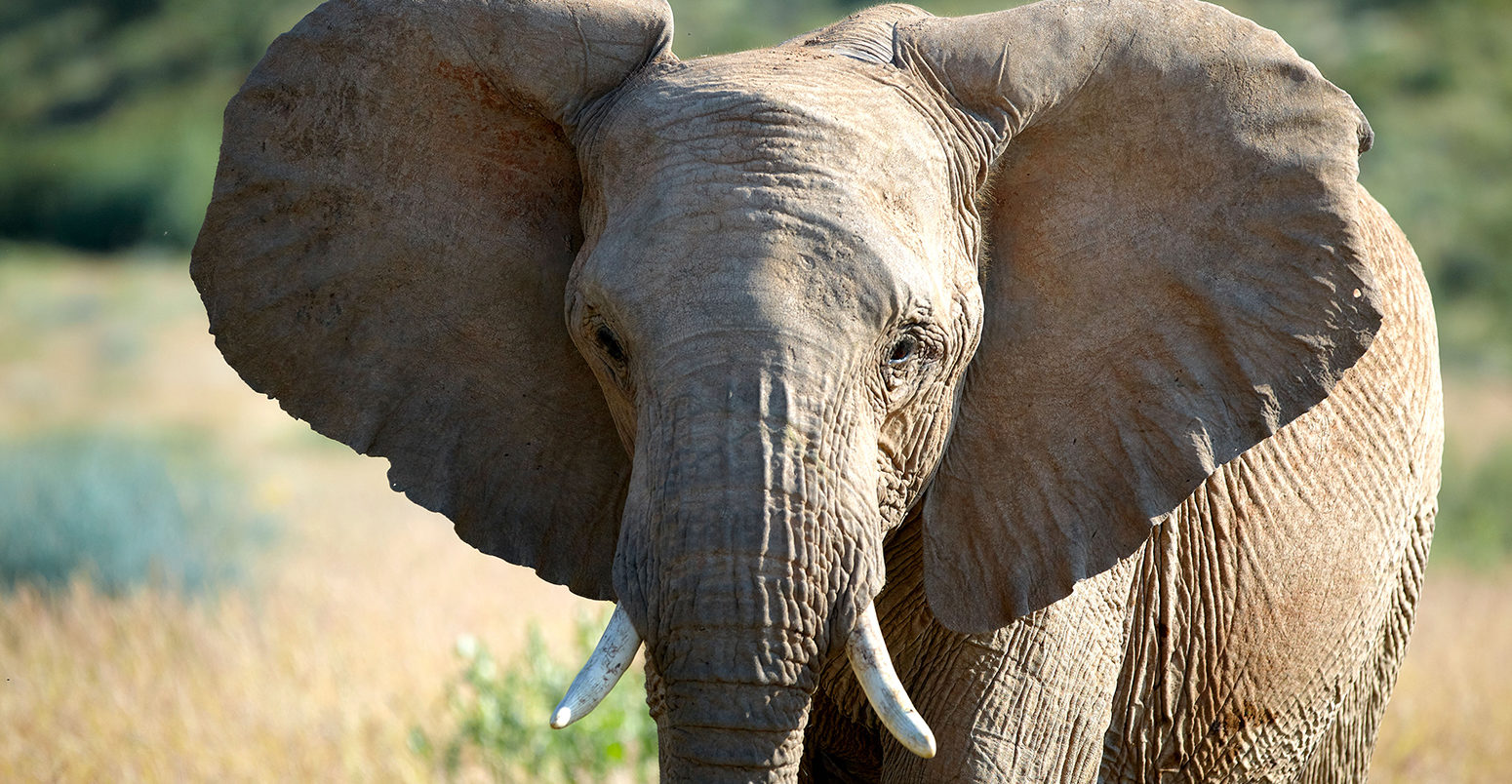
In-depth: Could ‘rewilding’ help to tackle climate change?
Daisy Dunne
10.22.18As little as 14,000 years ago, lions roamed across most of Earth’s continents, including Europe, Asia and the Americas.
Though it is not possible to tell what caused the lions to go extinct, evidence taken from fossils and ancient cave paintings suggests that human hunting could have played a role in their downfall.
Now, some researchers say that large animals, ranging from lions and elephants to giant tortoises and donkeys, should be reintroduced to areas where they once thrived.
It is argued that this type of conservation, which is known as “rewilding”, could help to restore ecosystems to what they could have looked like before major human interference.
A special issue published today by the Royal Society explores how rewilding could help to tackle climate change and its impacts, as well as how future warming could affect the success of rewilding schemes.
Could elephants tackle emissions?
One of the 16 research papers in the special issue, which is published in Philosophical Transactions of the Royal Society B, looks at how “trophic rewilding” could be used to lower greenhouse gas emissions.
Trophic rewilding refers to the restoration of dwindling or recently lost animal populations. (This is opposed to “Pleistocene rewilding”, which is concerned with reintroducing animals that have long been extinct in an area, such as the idea of returning mammoths to Siberia.)
The paper argues that reintroducing large herbivores, such as elephants, sloths and tapirs, could help countries to lower their emissions for several reasons.
Large herbivores were once a common sight in all of Earth’s habitable continents. However, hundreds of years of intensive livestock farming has contributed to steep declines in native herbivores and large increases in cattle. Today, there are around 1.5bn cows on Earth.
The replacement of native animals with cattle has caused steep rises in emissions of methane – a greenhouse gas that is 34 times more potent than CO2 over a 100-year period.
This is because cows are “ruminants” – meaning that they have specialised stomachs capable of digesting tough and fibrous material, such as grass through fermentation. The digestive process causes cows to belch out high amounts of methane.
Native herbivores, on the other hand, can have much smaller methane footprints. Many large herbivores, including rhinos, elephants and camels, are “hindgut fermenters” – meaning that they have a simple stomach and carry out fermentation of food in the large intestine.
This type of digestion produces much smaller amounts of methane, says study lead author Prof Joris Cromsigt, a researcher of megafauna (large animals) from the Swedish University of Agricultural Sciences.
However, to date, there has been no research comparing the methane footprints of different large herbivores and cattle, he tells Carbon Brief:
“Little empirical data is out there for wildlife. The largest emissions, per individual animal, come from large ruminants, such as cattle, and similar wild species, such as African buffalo or American bison. The least methane is, in principle, produced by the large non-ruminants, such as rhino, elephant and equid [horse] species.”
The figure below, taken from Cromsigt’s paper, gives a rough comparison of the methane emissions of different groups of animals.
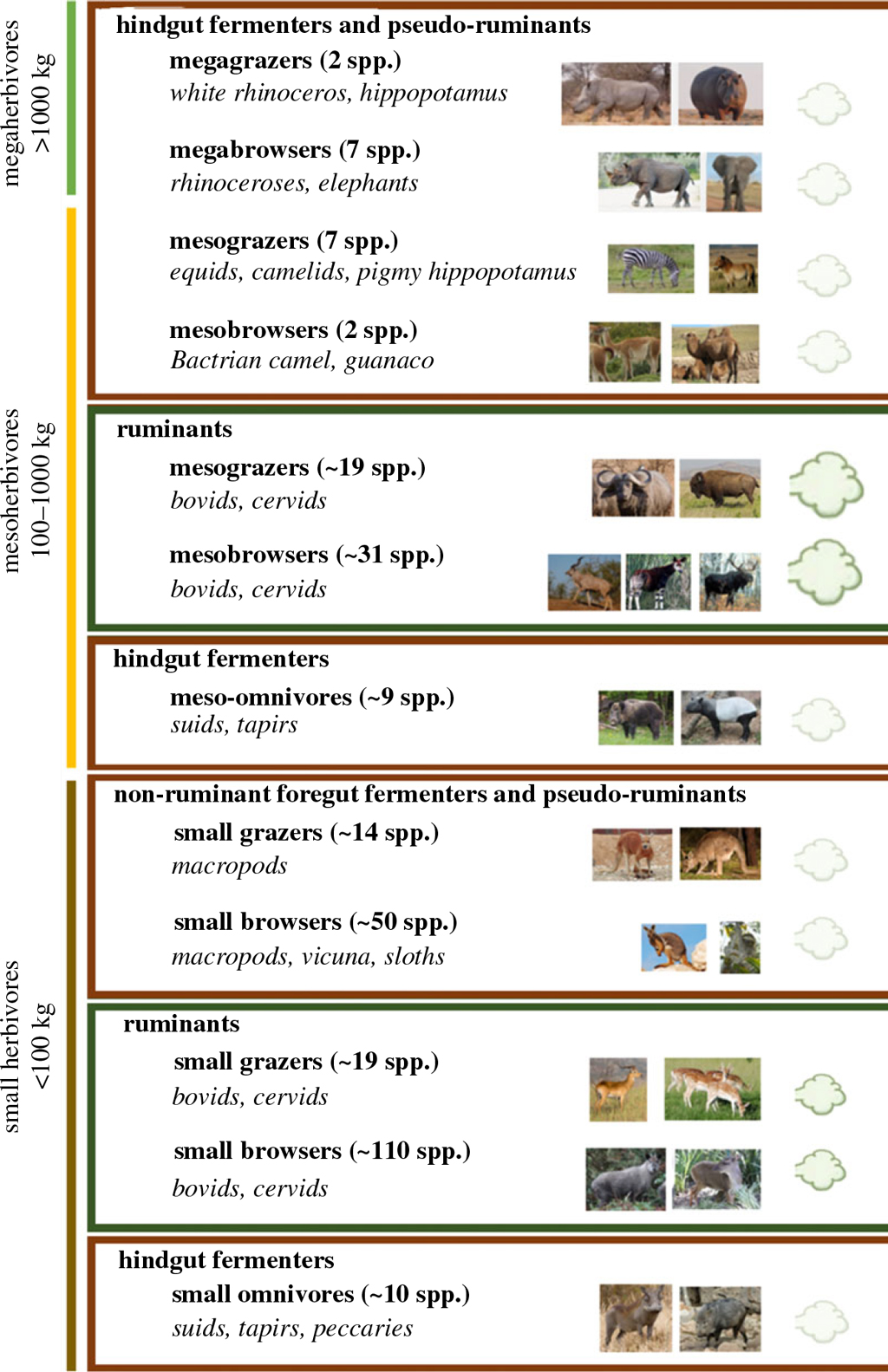
Comparison of the methane emissions of different groups of large herbivores. On the chart, a larger symbol represents larger overall methane emissions for that group. Source: Adapted from Cromsigt et al. (2018)
Research released in 2017 estimated that, over the past 1,000 years, the replacement of wildlife with cattle in Africa has caused methane emissions to more than double from 3.4m tonnes a year to 8.9m tonnes a year.
The reintroduction of large herbivores could also boost the carbon storage of forests, Cromsigt says.
This is because large herbivores act as long-distance seed dispersers for large fruit trees. In fact, research suggests that many large tree species in South America (such as the jicaro tree, shown below) may have evolved giant fruit in order to entice now-extinct large herbivores, such as the giant ground sloth.
Without large herbivores, numbers of the tallest and woodiest trees – which also store the most carbon – have declined. Additionally, research shows that the loss of living herbivores, such as American tapirs and African and Asian forest elephants, could cause the world’s tropical forests to lose between 2% and 12% of their stored carbon.
Costly conservation
It can be reasoned then, Cromsigt argues, that replacing cattle with wildlife could lower methane emissions, while boosting carbon stores in forests.
However, at present, many of the world’s large herbivores are critically endangered and face threats from poaching, habitat loss and conflict with humans. Research released this month found that humans have caused more than 300 mammal species to go extinct, undoing the work of millions of years of evolution.
One way to incentivise people to protect and try to restore wildlife numbers could be “to make it pay for itself”, Cromsigt says.
He points to an example of South Africa, where legislation introduced in 1991 gave people ownership over wildlife on their land. The new rules saw a massive rise in wildlife farms for game hunting, which led to the total estimated number of wild animals in the country rising from around 500,000 in the 1960s to close to 18m in 2010.
Cromsigt suggests that, if people switched from eating farmed beef to wild game, cattle ranchers could be incentivised to protect wildlife instead of cattle. He admits, however, that such a change would require “a radical cultural shift”.
Another way rewilding could be funded is through climate mitigation financing offered under the Paris Agreement. This money is being heavily invested in tree-planting schemes, but investing in wildlife could also help to boost tree numbers, Cromsigt argues:
“Why are these programmes not investing in fighting the bushmeat crisis and restocking our empty forests with megafauna frugivores [fruit eaters]…or stopping the current onslaught on African and Asia megafauna, such as elephants and rhinoceros?”
White rhinos and wildfires
As well as tackling the root cause of climate change, rewilding could be used to help humans and ecosystems adapt to some of its impacts, according to the special issue.
In many parts of the world, climate change is likely to be making wildfires more severe. This is because warming has led to higher summer temperatures and, in some regions, less summer rainfall – creating the dry, tinderbox conditions that enable fires to quickly spread.
Some large herbivores are thought to play a role in suppressing wildfires, according to a second paper in the special issue.
One reason for this is because large herbivores eat fallen leaves and vegetation, which would otherwise act as fuel in a fire.
Second, herbivores eat some plants, but leave others, which can change the makeup of plants in a forest. “This can mean that zones of low and high flammability are interspersed in arrangements that could impede the spread of landscape fires,” the authors say.
Third, some animals alter their forest landscapes by leaving trails or digging holes. The bare patches of land left behind from these activities can act as fire breaks, the researchers say:
“The physical scale of these features can be substantial. For example, in a montane vegetation complex in Tasmania, 10% or more of the ground surface was covered by animal paths, mostly created by medium-sized macropods [kangaroos and wallabies] and wombats.”
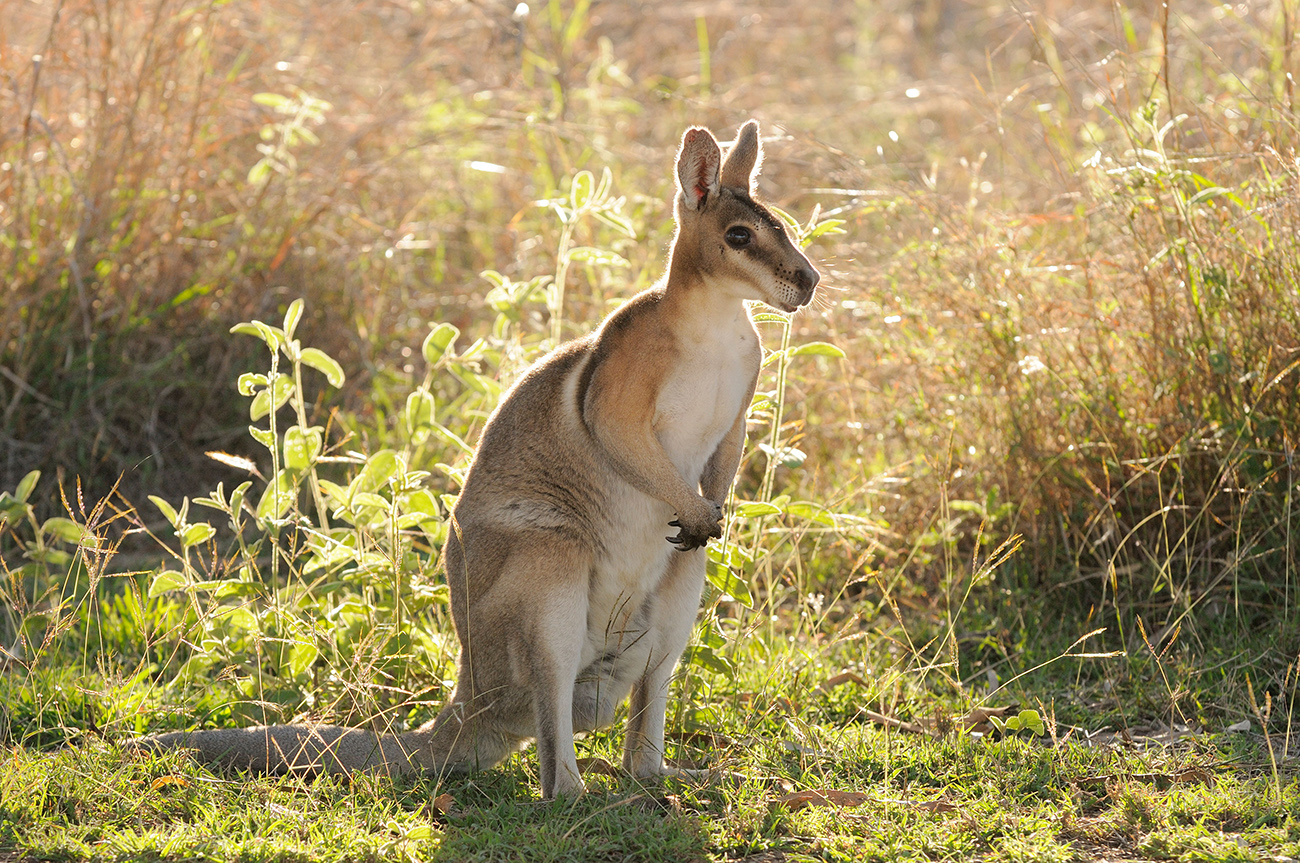
Bridled nailtail wallaby (Onychogalea fraenata), in Queensland, Australia. Credit: Dave Watts/Alamy Stock Photo.
Evidence suggests that, in some parts of the world, the reintroduction of large herbivores appears to have had an impact on wildfire intensity, the researchers say.
For example, earlier research shows that the reintroduction of white rhino to Hluhluwe iMfolozi National Park in South Africa could have impacted the severity of wildfires. White rhinos are thought to be efficient fire suppressors because they graze on tall grass, which can help fires spread between trees.
During an experiment, researchers removed white rhinos from some parts of the park and measured changes to grass height and wildfire size in areas both with and without rhinos.
The research found that fires were significantly larger in sites where rhinos were removed. This is shown in the chart below, where the total area covered by fire during the experiment is shown for areas with (black) and without (white) rhinos in the Hluhluwe and iMfolozi areas of the park.
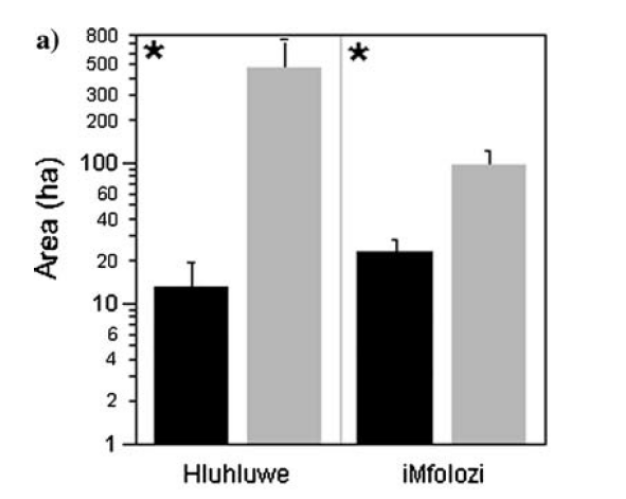
Impacts of rhino removals on fire size at Hluhluwe and iMfolozi locations. Black represents mean area of each fire with rhinos, and grey the area when rhinos were removed. Source: Waldram et al. (2008)
The research found that, in Hluhluwe, the removal of rhinos from test areas caused fires to increase 50-fold, from 10ha to 500ha, on average. In contrast, the removal of rhinos from test sites in iMfolozi caused fire area to become four times larger. (This could be because, in Hluhluwe, other herbivores were available to graze on tall grass, the authors say.)
These results suggest that reintroducing large herbivores could help to suppress wildfires in other parts of the world, such as in California, says study lead author Prof Christopher Johnson, an ecologist from the University of Tasmania. He tells Carbon Brief:
“There is evidence that climate change is increasing the risk of destructive fires in many parts of the world. Those same changes mean that traditional strategies of fire suppression and prevention work less well. Large herbivores – and some other animals – can stabilise fire regimes, and potentially make fire control more tractable and effective.”
Warming woes
While several papers in the special issue focus on how rewilding could help to address climate change, others explore how global warming could impact the success of existing rewilding projects.
In an opinion article, two scientists from the University of Zurich argue that climate change is likely to impact the success of rewilding projects involving giant tortoises on islands in the Indian Ocean.
Many different species of giant tortoise were once widespread across islands worldwide, including in Mauritius, the Galapagos and the Canary Islands. However, the arrival of humans to these islands saw many giant tortoises hunted to extinction.
The disappearance of giant tortoises is thought to have had detrimental impacts on islands, including the conversion of freshwater wetlands into bogs. This is because, like other large herbivores, giant tortoises act as long-distance seed dispersers.
To combat these changes, a rewilding programme was started in 2000 on Ile aux Aigrettes, a 25-hectare island off the coast of Mauritius. The programme introduced dozens of Aldabra giant tortoises, a close living relative to the extinct Mauritius giant tortoise.
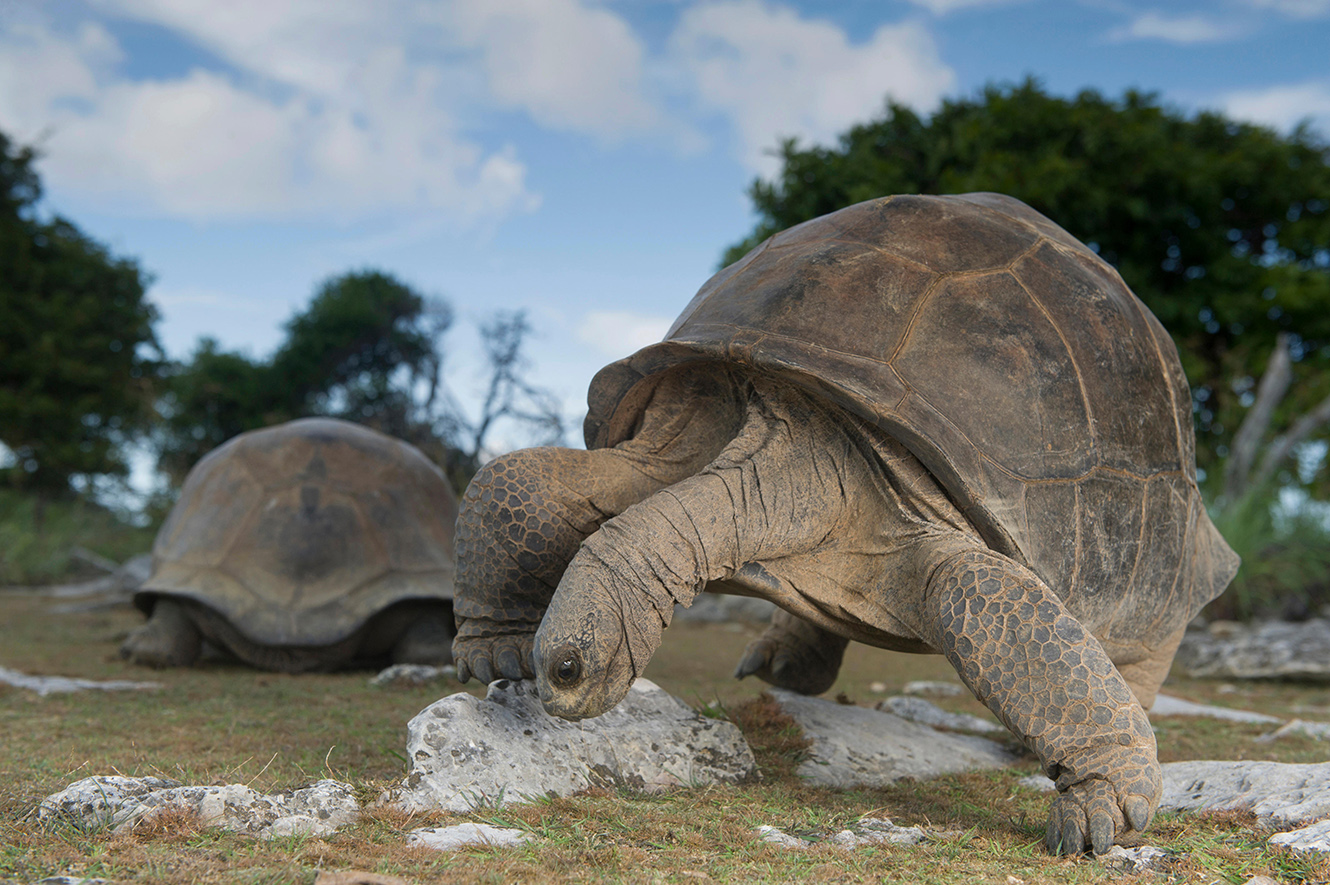
An Aldabra giant tortoise in a grazing area on Grand Terre Island. Credit: National Geographic Image Collection/Alamy Stock Photo.
Research shows that the reintroduction brought benefits to the island, including by boosting numbers of endangered ebony trees, which rely on the animals for seed dispersal.
However, climate change could impact the success of projects using tortoises, the researchers say. This is because tortoises are “ectothermic” reptiles – meaning they rely on their external environment to regulate their body temperature.
The reliance of tortoises on their external climate means that even small increases in temperature could threaten their survival, the researchers say:
“They are often rewilded to habitats that are at least seasonally dry, where the ability to successfully maintain their water balance can depend on very small margins.”
Tigers, lions and donkeys
A fourth paper in the special issue takes a look at how future climate change could impact where rewilding could be carried out across the globe for 17 different species.
![]()
Using current species distribution models and future climate projections, the researchers created maps showing where the climate could be suitable for each species at present (1950-2000) and in 2070.
The researchers use two scenarios for their projections, including a scenario with relatively low global emissions (“RCP2.6”) and a scenario with relatively high emissions (“RCP8.5”).
All of the species chosen for the analysis are suggested candidates for rewilding projects, the researchers say.
![]()
These include tigers, lions, leopards and cheetahs. These apex predators could have a positive impact on habitats by regulating numbers of their prey, research suggests.
Other animals on the list include several large herbivores, including muskox and red deer – which could play a role in maintaining Arctic tundra – and donkeys, which are known to dig wells that are used by other species.
The maps below show the current distribution of land that would provide a suitable habitat for the 17 different species. On the maps, white shows no suitability, warm colours show high suitability, while dark colours show a low, but present, suitability.
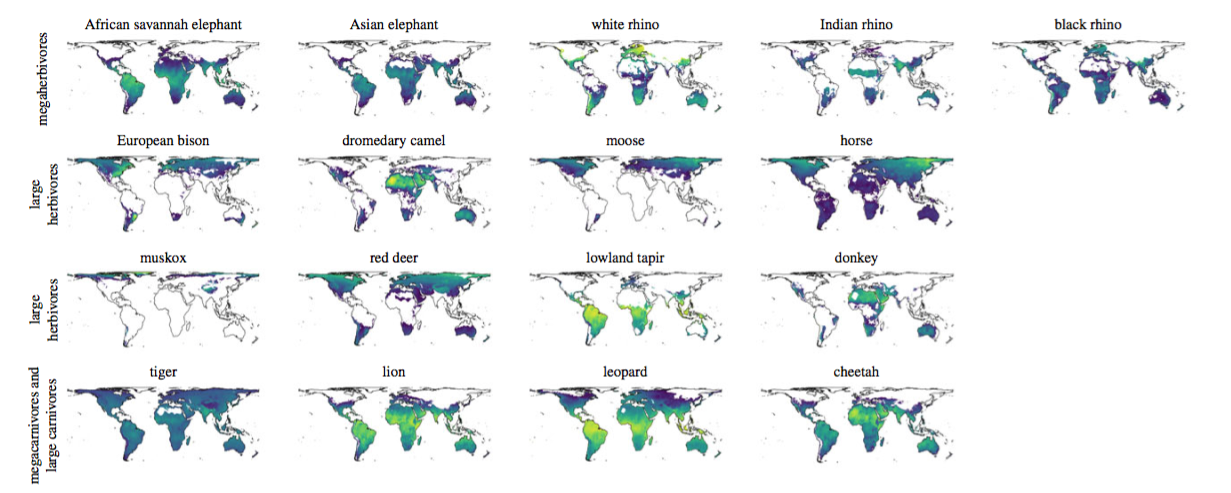
Global distribution of suitable habitat for 17 rewilding candidates at present day. White shows no suitability, warm colours show high suitability, while dark colours show a low, but present, suitability. Click on image to expand. Source: Jarvie and Svenning (2018)
The results show that, for many of the chosen species, the current range of suitable habitat across the world is much larger than the range in which they actually live. The results are instead more reflective of the animals’ prehistoric ranges, the researchers say.
The maps also show that, at present, many of parts of Australia could offer a suitable habitat for elephants and rhinos, the authors say:
“For suggested conservation introductions, regions of climatic suitability were predicted for both elephant species in most of Australia, parts of southern Europe and the Americas.”
The map below shows the distribution of suitable habitat for each species in 2070 under a high emissions scenario.
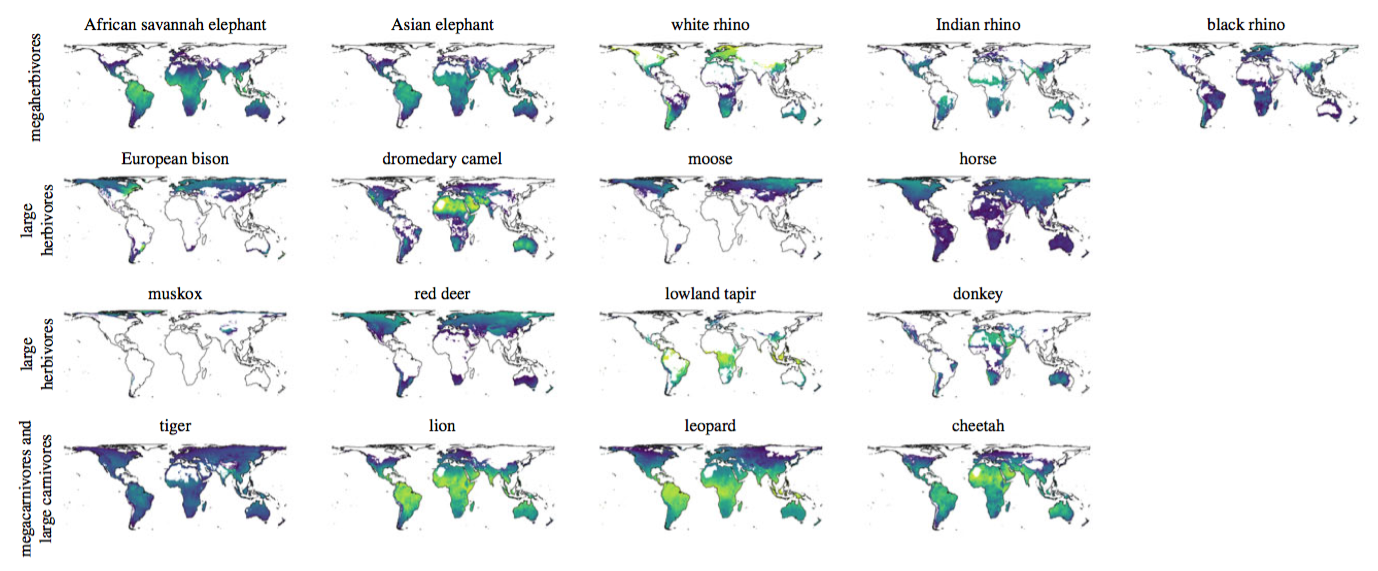
Global distribution of suitable habitat for 17 rewilding candidates at 2070 under a high emissions scenario (RCP8.5). White shows no suitability, warm colours show high suitability, while dark colours show a low, but present, suitability. Click on image to expand. Source: Jarvie and Svenning (2018)
The results show that, for many species, the total amount of area with a suitable climate remains relatively similar from present to 2070 under both the low and high emissions scenario.
However, the total amount of land suitable fell for other species, including African and Asian elephants, white and black rhinos and muskox and tapirs. For tigers, climate suitability fell in the Indian subcontinent – which has been earmarked as a key area for tiger conservation.
Multiple authors (2018) Trophic rewilding: consequences for ecosystems under global change, Philosophical Transactions of the Royal Society B, http://rstb.royalsocietypublishing.org/content/373/1761
-
In-depth: Could ‘rewilding’ help to tackle climate change?
-
In-depth: How reintroducing large animals to ecosystems could tackle global warming


